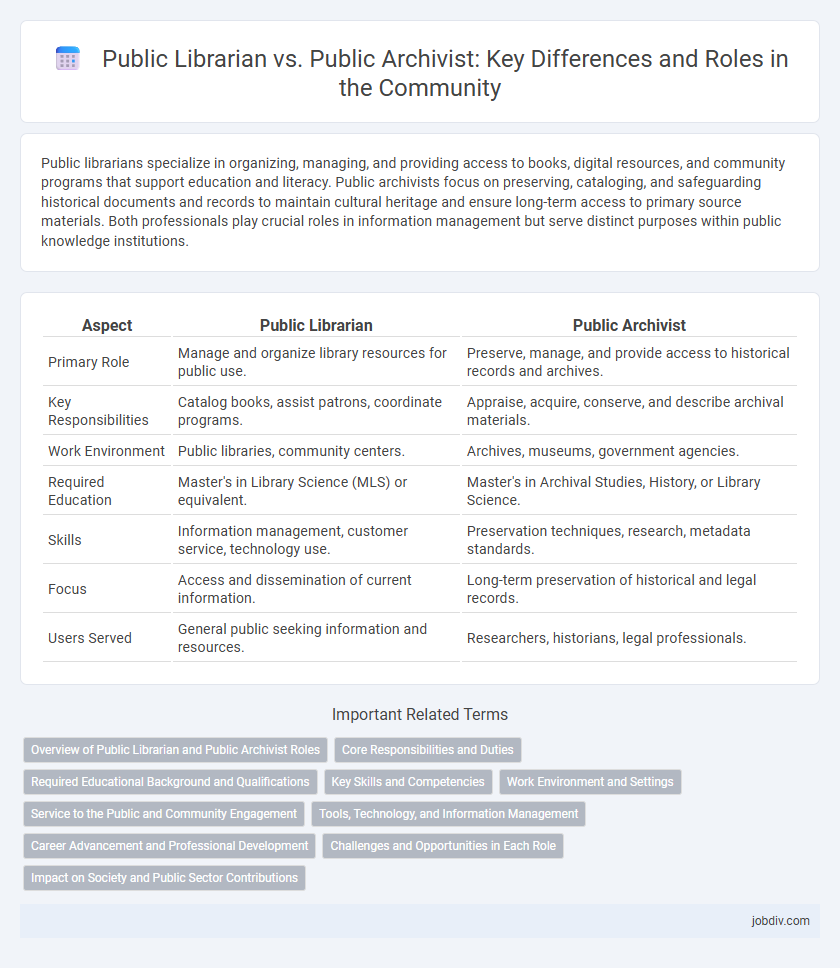Public librarians specialize in organizing, managing, and providing access to books, digital resources, and community programs that support education and literacy. Public archivists focus on preserving, cataloging, and safeguarding historical documents and records to maintain cultural heritage and ensure long-term access to primary source materials. Both professionals play crucial roles in information management but serve distinct purposes within public knowledge institutions.
Table of Comparison
| Aspect | Public Librarian | Public Archivist |
|---|---|---|
| Primary Role | Manage and organize library resources for public use. | Preserve, manage, and provide access to historical records and archives. |
| Key Responsibilities | Catalog books, assist patrons, coordinate programs. | Appraise, acquire, conserve, and describe archival materials. |
| Work Environment | Public libraries, community centers. | Archives, museums, government agencies. |
| Required Education | Master's in Library Science (MLS) or equivalent. | Master's in Archival Studies, History, or Library Science. |
| Skills | Information management, customer service, technology use. | Preservation techniques, research, metadata standards. |
| Focus | Access and dissemination of current information. | Long-term preservation of historical and legal records. |
| Users Served | General public seeking information and resources. | Researchers, historians, legal professionals. |
Overview of Public Librarian and Public Archivist Roles
Public Librarians manage and curate collections of books, digital media, and resources to support community education and literacy, often providing programs and reference services. Public Archivists specialize in preserving, organizing, and providing access to historical documents, records, and artifacts critical to cultural heritage and research. Both roles require expertise in information management but differ in focus: librarians emphasize current informational needs while archivists prioritize long-term preservation.
Core Responsibilities and Duties
Public librarians manage information access and literacy programs by organizing collections, assisting patrons with research, and facilitating community events. Public archivists focus on preserving, appraising, and maintaining historical records and documents, ensuring their long-term accessibility and authenticity. Both professions require expertise in information management but differ in scope, with librarians prioritizing public engagement and archivists concentrating on preservation and documentation.
Required Educational Background and Qualifications
Public librarians typically hold a Master of Library Science (MLS) or Master of Library and Information Science (MLIS) degree from an American Library Association (ALA)-accredited program, emphasizing library management, information organization, and reference services. Public archivists generally require a master's degree in archival studies, history, or a related field, often supplemented by specific archival certifications such as the Academy of Certified Archivists (ACA) credential. Both professions demand strong research skills, knowledge of preservation techniques, and proficiency in digital cataloging systems relevant to managing public collections.
Key Skills and Competencies
Public librarians excel in customer service, information literacy, and collection development, ensuring accessible resources for diverse communities. Public archivists specialize in appraisal, preservation, and archival description, managing historically significant records with precision. Both roles require strong organizational skills, attention to detail, and proficiency in digital tools to support information stewardship.
Work Environment and Settings
Public librarians typically work in community-centered environments such as local libraries, providing access to books, digital media, and educational programs for diverse populations. Public archivists operate within specialized settings like government agencies, museums, or historical societies, managing, preserving, and organizing collections of records and documents. Both roles require collaboration with the public, but librarians focus on information dissemination, while archivists emphasize the preservation of historical and legal materials.
Service to the Public and Community Engagement
Public librarians provide accessible literacy resources, organize educational programs, and support lifelong learning to promote community engagement and enhance public knowledge. Public archivists preserve, manage, and provide access to historical records and documents, ensuring the community's cultural heritage remains available for research and education. Both professions prioritize public service by facilitating information access and fostering community connections through tailored outreach initiatives.
Tools, Technology, and Information Management
Public librarians utilize integrated library systems (ILS) and digital catalog platforms to manage circulating collections, enhancing user access through online public access catalogs (OPACs) and e-resources. Public archivists employ archival management software like ArchivesSpace and digital preservation tools to organize, describe, and conserve primary records, ensuring long-term access and provenance tracking. Both professions leverage metadata standards and information retrieval systems tailored to the unique requirements of circulating materials versus historical document preservation.
Career Advancement and Professional Development
Public librarians advance their careers by specializing in information management, community engagement, and digital literacy, often pursuing certifications like the Master of Library Science (MLS) or continuing education in emerging technologies. Public archivists focus on preserving historical records, requiring expertise in archival science, records management, and sometimes advanced degrees such as a Master of Archival Studies or involvement in professional organizations like the Society of American Archivists. Both professions emphasize ongoing professional development through workshops, conferences, and skill-building to stay current with evolving information standards and technologies.
Challenges and Opportunities in Each Role
Public librarians face challenges in managing diverse collections and meeting evolving community needs while leveraging digital technologies to enhance access and engagement. Public archivists confront issues related to preserving fragile historical records and ensuring accurate metadata, creating opportunities to implement advanced digital preservation methods and improve discoverability. Both roles require adaptability and collaboration to navigate shifting information landscapes and support public access to knowledge.
Impact on Society and Public Sector Contributions
Public librarians foster community engagement by providing accessible information, educational programs, and digital literacy resources, significantly enhancing public knowledge and social inclusion. Public archivists preserve and manage historical records, ensuring transparency, accountability, and cultural heritage protection within the public sector. Both roles are essential in supporting informed citizenship and maintaining the integrity of public information systems.
Public Librarian vs Public Archivist Infographic

 jobdiv.com
jobdiv.com